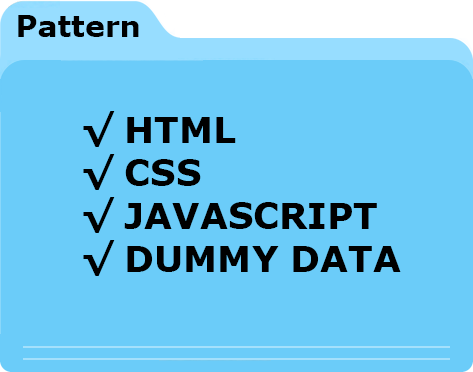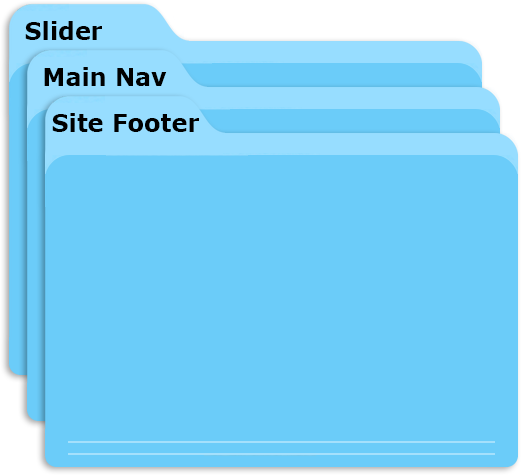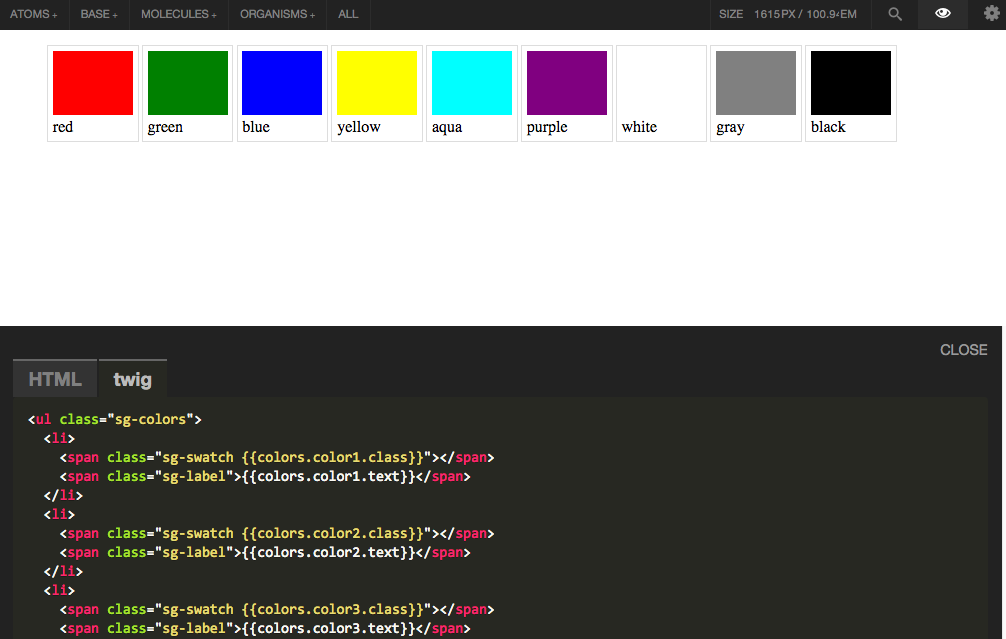Pattern Library
- What is a pattern?
- What is a pattern library?
- GitHub Repositories
- How to create a pattern library
- List of Gulp tasks
- Parts of a Pattern
What is a pattern?
A pattern is a reusable, functional, html-based component.
Each pattern is packaged with:
- an HTML file (in your templating languge-of-choice)
- dummy data
- javascript
- css (in your css compiler-of-choice)

What is a pattern library?
A NodeJS storage-and-sharing solution for your functioning UX patterns.
Each pattern library:
√ Organizes your patterns

√ Publishes your work online to GitHub Pages
√ Includes tools for designing in browser

GitHub Repositories
Pattern Libraray Generator
Scaffolds a new pattern library
github.com/pattern-library/generator-pattern-library
- Creates a new pattern library
- Build using Yeoman
- Optionally creates a new html component which includes:
- YAML-based data file
- A pattern’s markup, in html or twig
- Optional SASS file
- Optional JS file
- Detailed README file
Pattern Library
A complete pattern library containing base html elements for styling
github.com/pattern-library/pattern-library
- Contains base html elements
- Atomic Design atoms/molecule levels
- Base patterns are used to style basic html elements
- Has full gulp functionality
- Built with the Pattern Library Generator
Pattern Library Utilities
github.com/pattern-library/pattern-library-utilities
- Adds gulp functionality to your pattern libraries, such as:
- Watching files
- Creating a server
- Installing Pattern Lab
- Contains javascript modules that:
- Import patterns into Pattern Lab and other systems
- Convert twig include paths inside twig templates
- Convert YAML data into JSON
- Get options for gulp tasks
- Contains gulp tasks that can be imported into a project’s gulpfile.js and used by adding configuration (see the List of Gulp tasks)
How to create a pattern library
-
Install the pattern library generator
npm install -g generator-pattern-library -
Run the generator in an empty repository
yo pattern-librarya. Ccaffolds out the pattern library structure
b. Installs NPM dependencies
c. Scaffolds out a global assets directory -
Install Pattern Lab for prototyping
gulp builda. Installs Pattern Lab using composer
b. Copies patterns and javascript into Pattern Lab ./source
c. Copies global assets into Pattern Lab -
Serve files and begin development
gulp servea. Creates
<script>tags for javascript files
b. Creates@importstatements for scss files
c. Compiles scss
d. Triggers a PHP Pattern Lab build
e. Uses browsersync to create a server for Pattern Lab
f. Maintains a watch on files
g. Refreshes browser on file changes
List of Gulp tasks
note: You can always type gulp help to see a list of available gulp tasks.
Notable tasks:
gulp build- Installs Pattern Lab
- Imports your pattern library into Pattern Lab
- Imports from other pattern libraries
gulp serve- Development server
- Browser refresh on file changes
gulp hPages- Deploys Pattern Lab’s public directory to GitHub Pages
gulp glob-inject-js-all- Globs all javascript files
- Writes
<script>tags into your html
gulp glob-inject-sass-all- Globs all sass files
- Writes
@importstatements into your scss
gulp help- Lists available gulp tasks
gulp patternlab-build-public- Triggers Pattern Lab’s build system
gulp patternlab-clean- Prepares Pattern Lab’s source folder for the pattern library
gulp patternlab-install- Installs Pattern Lab
gulp patterns-import-all- Imports patterns from local and npm into Pattern Lab
gulp sass- SASS file compilation
gulp global-assets-import-all- All global asset imported into Pattern Lab
gulp watch- watch tasks for all different types of files
Parts of a Pattern
Contents and Directory Structure
These are the files which may be in a single HTML pattern’s directory. This imaginary pattern is called example-pattern.
The only required files are pattern.yml and a pattern file (in any templating language or plain html.)
 example-pattern/
example-pattern/
 pattern.yml
pattern.yml example-pattern.twig
example-pattern.twig example-pattern.js
example-pattern.js README.md
README.md example-pattern.scss
example-pattern.scss
Pattern YAML File
pattern.yml, required
Each single pattern folder must contain a pattern.yml file.
This file contains paths to find supporting files, meta data, and dummy data to populate the pattern for testing purposes.
This example is from the Figure Image pattern, which is included in the base pattern library.
name: Figure Image
description: A `figure` element with `figcaption` and an included `img` element from /atoms/images/img/img.twig.
twig: figure-image.twig
category: molecules
subcategory: media
data:
figure:
img:
src: http://placehold.it/350x150&text=figure__image
alt: Aenean commodo ligula eget dolor. Aenean massa.
class: figure__image
caption:
text: Aenean commodo ligula eget dolor. Aenean massa. Cumo sociis natoque penatibus et magnis dis parturient montes, nascetur ridiculus mus.
class: base__figure-image
Template File
example-pattern.twig, required
Each pattern folder must contain a [pattern-name].[template-lang] (example-pattern.twig) file. These files should not contain actual text, data, images, etc. Instead, patterns use curly-braces as data placeholders. Even if they are .html files.
Other Optional Included Files
README.md
Should include usage examples
PATTERN.js
A pattern’s javascript file. Include in pattern.yml like this:
...
script: example-pattern.js
...
Can optionally be an array:
...
script:
- example-pattern.js
- example-pattern-file2.js
...
PATTERN.css
A CSS file. Include in pattern.yml like this:
...
css: example-pattern.css
...
PATTERN.scss
A SASS file. NOTE: do not prefix this file with an underscore or it will be ignored when import-conversion happens. Include in pattern.yml like this:
...
sass: example-pattern.scss
...
Can optionally be an array:
...
sass:
- example-pattern.scss
- example-pattern-file2.scss
...
